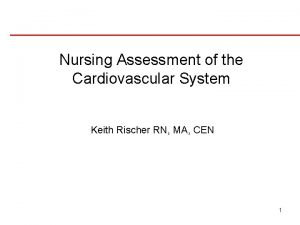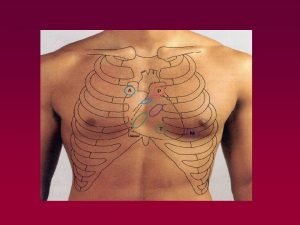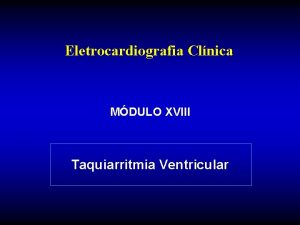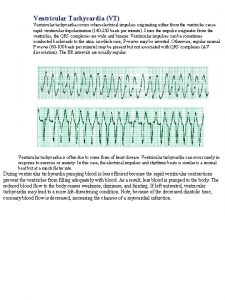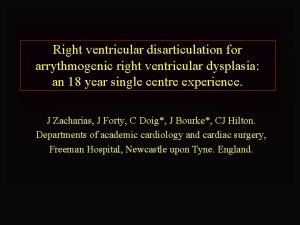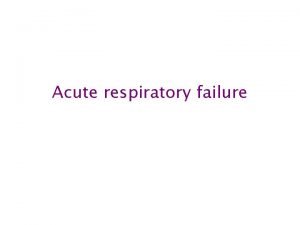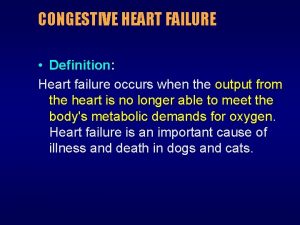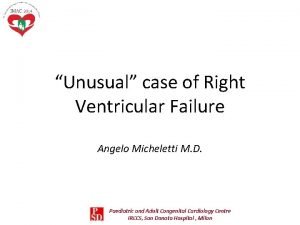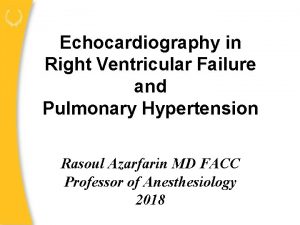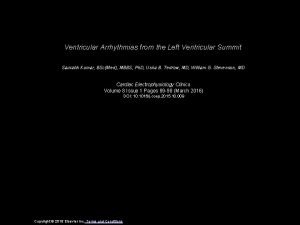Right Ventricular Failure RVF Occurs when the right













- Slides: 13



Right Ventricular Failure (RVF) • Occurs when the right ventricle fails as an effective forward pump, causing back-pressure of blood into the systemic venous circulation • Can result from: – Chronic hypertension (in which LVF usually precedes RVF) – COPD – Pulmonary embolism – Valvular heart disease – Right ventricular infarction • RVF most commonly results from LVF

RVF • Signs and symptoms – Tachycardia – Venous congestion • Engorged liver, spleen, or both • Venous distention; distention and pulsations of the neck veins – Peripheral edema – Fluid accumulation in serous cavities – History--common signs and symptoms of acute rightsided heart failure include chest pain, hypotension, and distended neck veins • Management

Left Ventricular Failure (LVF) and Pulmonary Edema • LVF occurs when the left ventricle fails to function as an effective forward pump, causing a back-pressure of blood into the pulmonary circulation • May be caused by a variety of forms of heart disease including ischemic, valvular, and hypertensive heart disease • Untreated, significant LVF culminates in pulmonary edema

LVF • Signs and symptoms – – – – Severe respiratory distress Severe apprehension, agitation, confusion Cyanosis (if severe) Diaphoresis Adventitious lung sounds JVD Abnormal vital signs • Management

Cardiogenic Shock • The most extreme form of pump failure • Occurs when left ventricular function is so compromised that the heart cannot meet the metabolic needs of the body • Usually caused by extensive myocardial infarction, often involving more than 40% of the left ventricle, or by diffuse ischemia • Signs and symptoms • Management




Cardiac Tamponade • Impaired diastolic filling of the heart caused by increased intrapericardial pressure and volume – As the volume of pericardial fluid encroaches on the capacity of the atria and ventricles to fill adequately, ventricular filling is mechanically limited and stoke volume is decreased • Causes • Signs and symptoms • Management

Cor Pulmonale • A condition of Rt. Ventricular Failure due to pulmonary hypertension secondary to a disease of the pulmonary blood vessels. • A pulmonary embolus can cause an acute dilatation of the ventricle requiring emergent measures. • Chronic Cor Pulmonale develops from COPD/emphazema, and/or fibrosis.

 Cardiac landmarks
Cardiac landmarks Rvf vs lvf
Rvf vs lvf Right product right place right time right price
Right product right place right time right price Family time
Family time Failure to sense
Failure to sense Failure to pace
Failure to pace Brittle fracture vs ductile fracture
Brittle fracture vs ductile fracture Normal pulmonary artery pressure
Normal pulmonary artery pressure The right man on the right place at the right time
The right man on the right place at the right time Right vs left-sided heart failure chart
Right vs left-sided heart failure chart O-ring seal failure in right srb
O-ring seal failure in right srb Nursing assessment for congestive heart failure
Nursing assessment for congestive heart failure Pericardium fibrous
Pericardium fibrous Taquicardia ventricular monomórfica
Taquicardia ventricular monomórfica
